Museum of the Manchester Regiment Object Focus
Her Majesty’s Regimental Brooch
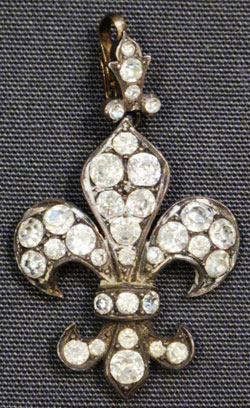 Her Majesty Queen Elizabeth (later, Her Majesty Queen Elizabeth, The Queen Mother) assumed the role of Colonel-in-Chief of The Manchester Regiment by commission from her husband King George VI on 5th May 1947.
Her Majesty Queen Elizabeth (later, Her Majesty Queen Elizabeth, The Queen Mother) assumed the role of Colonel-in-Chief of The Manchester Regiment by commission from her husband King George VI on 5th May 1947.
Her appointment ensured the continuation of a member of the British Royal family adopting a non-operational role as patron or Colonel-in-Chief of the Regiment. She followed in the footsteps of her father-in-law King George V who occupied the role from 1929 to his death in 1936.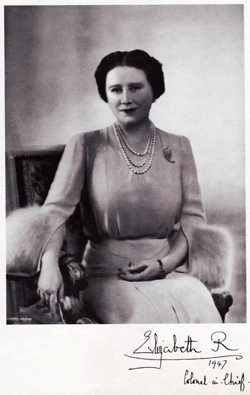
On the 26 April 1947, The Times announced the appointment of Major-General Charles Dawson Moorhead CB, DSO, MC as Colonel-of-the-Regiment of the Manchester Regiment, who had been commissioned into the Regiment in 1915. He succeeded Colonel Francis Holland Dorling who was pivotal in the establishment of the Regimental Museum and the Regimental Chapel.
The new Colonel-of-the-Regiment and Colonel-in-Chief began a correspondence which was documented regularly in The Regimental Gazette: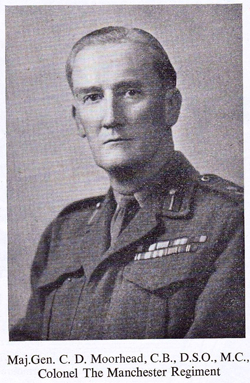
“Please convey to Her Majesty the Queen the deep appreciation that is felt by ALL ranks of The Manchester Regiment of the honour Her Majesty has conferred on them by becoming their Colonel-in-Chief. All ranks send their loyal greetings.” (Moorhead, Colonel, The Manchester Regiment).
On 9 March 1948 Major-General Moorhead resigned the Colonelcy due to other commitments and Major-General Eric Boyd Costin DSO was appointed as the new Colonel-of-the-Regiment.
Queen Elizabeth’s patronage as Colonel-in-Chief was a proud moment in the history of the Regiment. The Regimental Gazette, issued a souvenir booklet in the June 1947 edition featuring a signed portrait photograph of Queen Elizabeth and a copy of the telegram she released. The gazette extended the sentiment expressed by Colonel Moorhead:
“We would assure her (the Queen) that her appointment will spur us, one and all, to still further efforts to carry on the great traditions of the Regiment.”
To mark the occasion, it was decided that the Regiment should present Queen Elizabeth with a gift in the form of a Regimental brooch, a suggestion made by the members of The Old Comrades Association in the June edition of the Gazette.
Thus a beautiful silver Fleur-de-lys brooch decorated with intricate diamonds was chosen to represent both the Regiment’s history and traditions and Her Majesty’s Royal status. The Fleur-de-lys symbol had been representative of the Regiment for centuries being first in use with the earliest regular battalion, the 63rd Regiment of Foot, from the 18th Century.
The Fleur-de-Lys was closely and honourably linked to the Regiment and was therefore befitting of its Royal Colonel-in-Chief. The brooch was presented to Queen Elizabeth by Colonel Moorhead during a ceremony held at Buckingham Palace on 10 December 1947.
The First Visit by Her Majesty Queen Elizabeth to Dunham Park Camp, 1 June 1948.
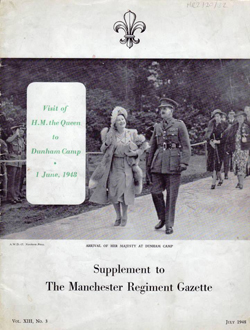 On 1 June 1948 Queen Elizabeth made her first visit as Colonel-in-Chief to Dunham Park Camp, the Depot and Head Quarters of the Manchester Regiment at that time. All branches of the Regiment were involved in the preparations for the event. The Regimental band played and all ranks, battalions and companies took part in a march-past and parade.
On 1 June 1948 Queen Elizabeth made her first visit as Colonel-in-Chief to Dunham Park Camp, the Depot and Head Quarters of the Manchester Regiment at that time. All branches of the Regiment were involved in the preparations for the event. The Regimental band played and all ranks, battalions and companies took part in a march-past and parade.
The Queen conducted an inspection of the 1st Battalion, 8th Battalion, 9th Battalion, Army Cadets and the Old Comrades Association, and decorated some with medals and awards. Afterwards there was a reunion tea where soldiers past and present dined along with their families. The Queen took tea on the lawn with around four hundred members of the Officers’ Mess.
Major-General Costin summarised the Queen’s visit in the souvenir booklet that accompanied the June edition of The Regimental Gazette. He conveyed the pleasure that all ranks and their relatives felt regarding the preparations for the visit and in enjoying the day itself:
“The success of the day was in no small measure due to Her Majesty herself who, by her charm and understanding, endeared herself to us all. If proof were needed, the delighted remarks of those who pressed around her as she strolled through the “families” enclosure amply showed the pleasure she gave.”
The Queen gave a speech during which she again conveyed her enjoyment at being the Regiment’s Colonel-in-Chief. She made reference to the history and traditions of the Regiment, the battles of the Second World War which were at that time foremost in the memories of those present, and of the pride felt throughout the Regiment as representatives of their region and country.
The Queen made the following comments of Britain and her soldiers, which perhaps summarised the mood and sentiment of the times:
“Do not forget that your country and its way of living, will be judged by your bearing; and by setting an example of tolerance, discipline and good manners, you will maintain the honoured tradition that a British soldier is an ambassador for peace.”
Queen Elizabeth continued to play an active role as Colonel-in-Chief until 1958 when the Regiment amalgamated with the King’s Regiment (Liverpool), to form the new Kings Regiment. She regularly attended regimental events and took a keen interest in the affairs of the Regiment, most of which has been documented in the Regimental Gazette.
She was by that time known more widely as The Queen Mother to Queen Elizabeth II, her daughter, whose Coronation took place on 2 June 1953. the Queen Mother remained Colonel-of-the-Regiment until her death in 2002.
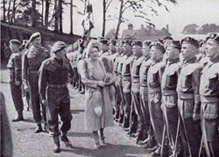
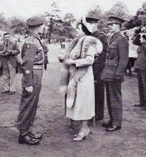
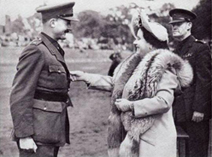
Sources:
The Manchester Regiment Gazette: Vol. XII, July 1947, No.6 (MR3/20/51)
The Manchester Regiment Gazette: Vol. XIII, July 1948, No.3, (Supplement) (MR2/20/32)
The Manchester Regiment Gazette: Vol. XIII, January 1948, No.1 (MR3/20/52)
Difficulties be Damned by Patrick Mileham
History of the Manchester Regiment by Col A.C Bell
This article was researched and written by Ms Ruth Beattie (Student of Contemporary Military and International History at Salford University) during her placement at the Museum of the Manchester Regiment in April 2011.

